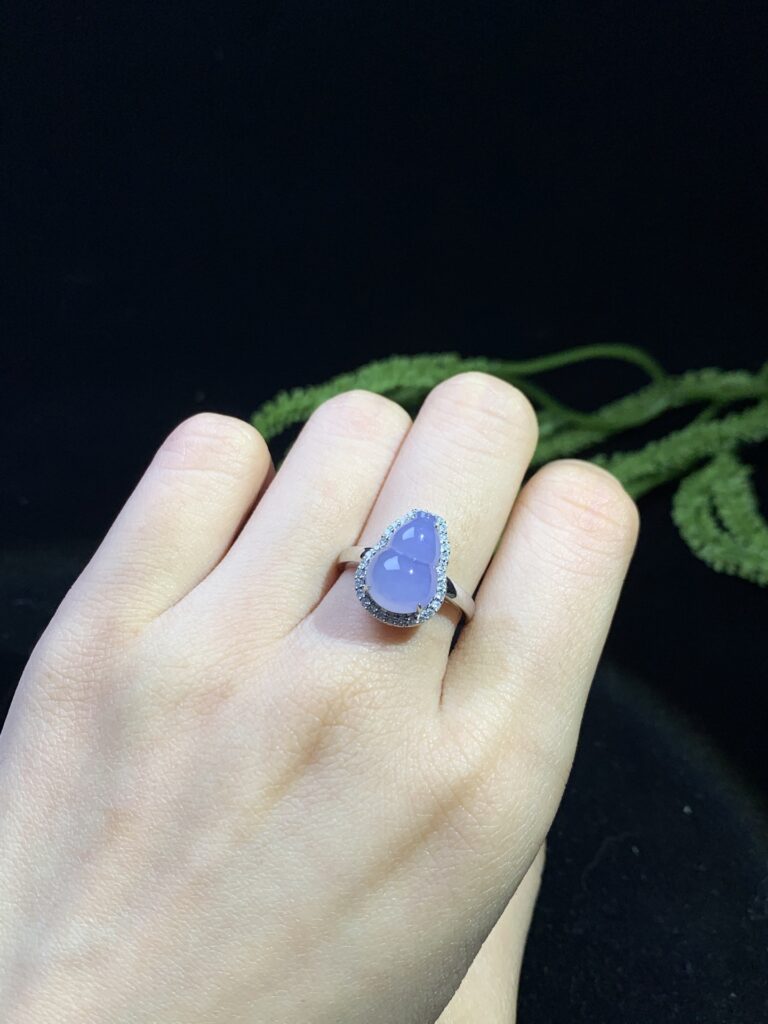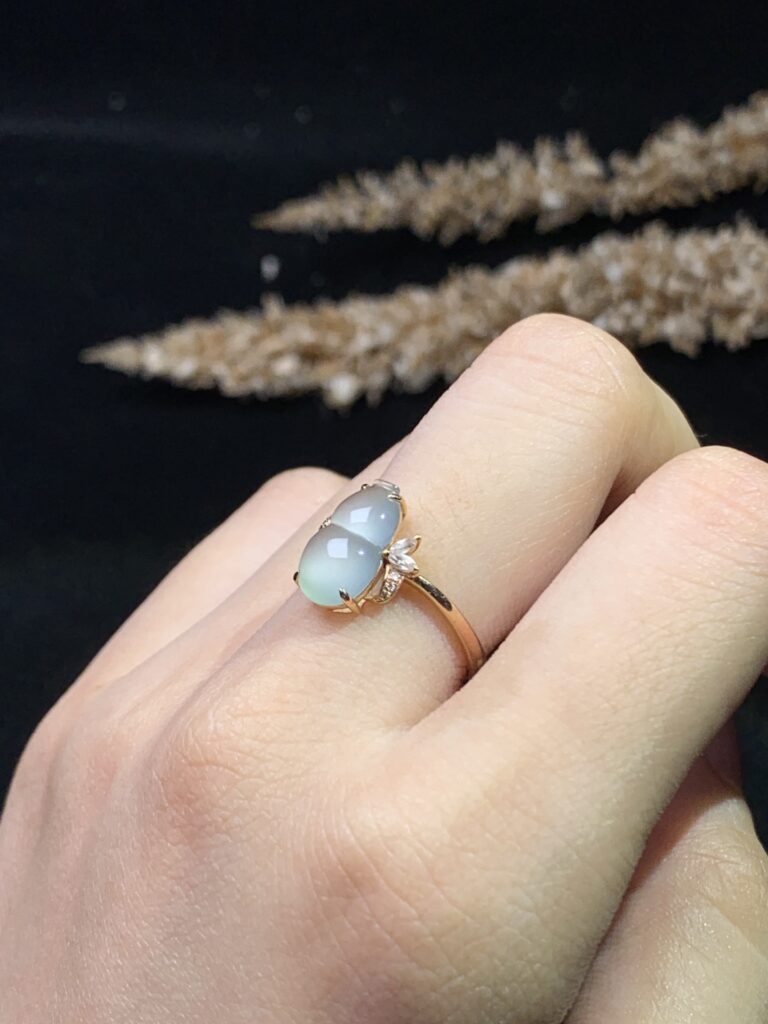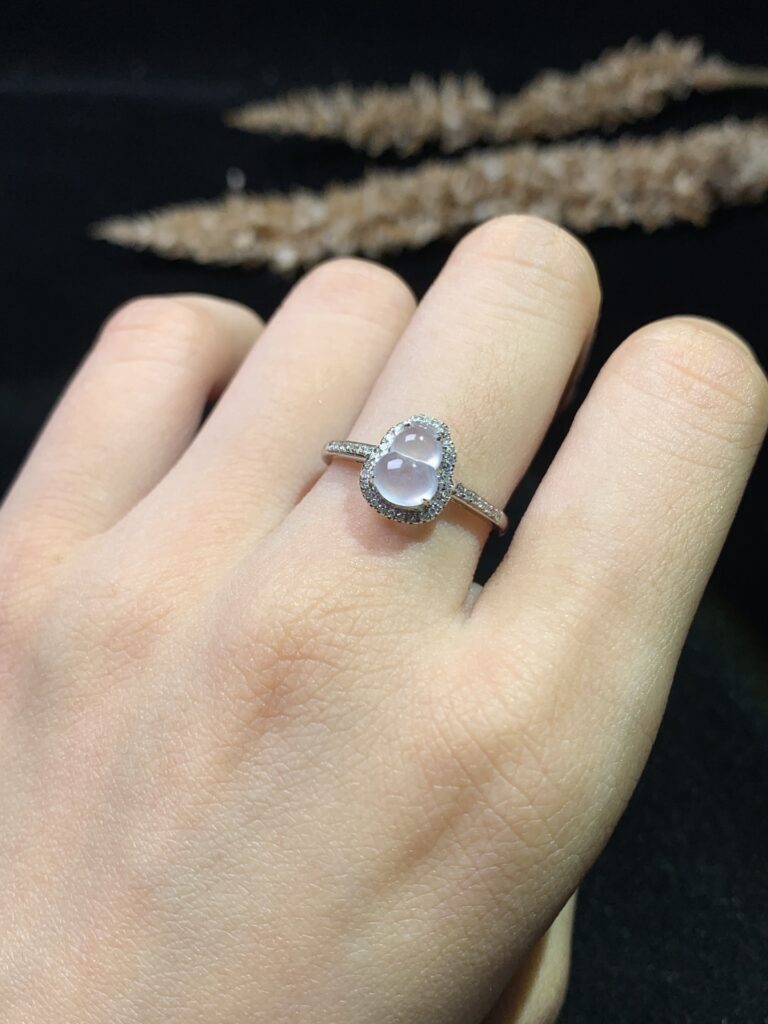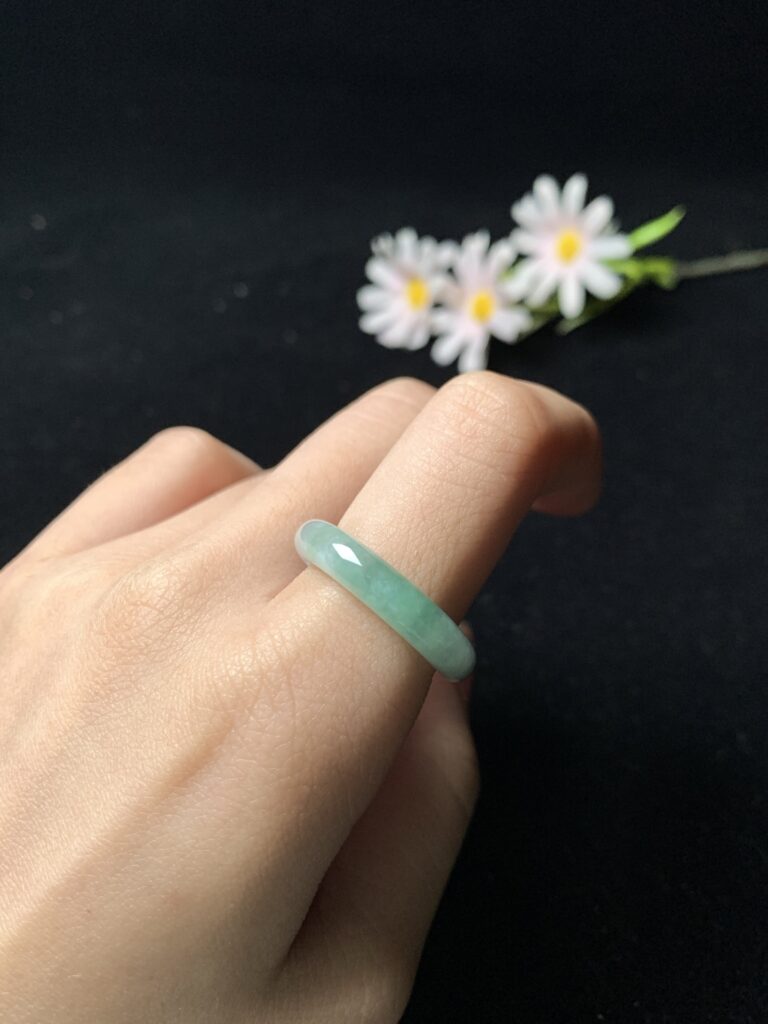Table of Contents

1: Introduction – Why Jade Ring Jewelry Still Captivates Us in 2025
In an era dominated by fast fashion and fleeting trends, some forms of adornment remain untouched by time. Among them, jade ring jewelry stands as a powerful symbol of permanence, elegance, and spiritual resonance. Even in 2025, the fascination with jade is stronger than ever, as modern wearers seek pieces that not only beautify but also ground, protect, and connect them with deeper meaning.
Jade is more than a gemstone—it’s a living symbol of culture and belief. From ancient Chinese dynasties to global collectors and spiritual seekers today, jade rings have consistently represented virtues like peace, prosperity, harmony, and strength. For many, wearing jade ring jewelry is not just a fashion choice; it is an emotional statement, a reminder of identity, legacy, and energy.
In the West, where jade was once considered exotic, there is now a growing appreciation for its history and meaning. As consumers become more mindful, they’re drawn to jewelry that tells a story. A jade ring—smooth, cool, and often hand-carved—is more than a decorative item; it’s an heirloom in the making, a quiet talisman for daily strength and elegance.
Moreover, jade ring jewelry aligns perfectly with the values of 2025’s global aesthetic: minimal yet intentional, natural yet luxurious, personal yet universal. Its durability makes it practical; its symbolism makes it powerful. Whether worn for fashion, spiritual energy, or cultural pride, jade rings continue to captivate hearts and minds across generations.
In this guide, we explore why jade has earned its place as one of the most meaningful gemstones in human history—and how jade rings have come to represent a timeless blend of beauty, spirit, and emotional depth.
2: From Mountains to Memories – The Ancient Origins of Jade Jewelry
The story of jade ring jewelry doesn’t begin in a jewelry boutique or a luxury brand catalog. It starts thousands of years ago, in rugged mountain terrains and riverbeds rich with jadeite and nephrite—two distinct types of jade. For millennia, jade has been extracted, honored, and transformed into symbols of status, faith, and human connection.
In ancient China, jade was called “yu” (玉), meaning “heavenly stone.” It was believed to embody the five cardinal virtues: benevolence, righteousness, wisdom, courage, and integrity. Emperors, scholars, and nobles wore jade rings not merely for decoration but as sacred symbols of personal virtue and cosmic alignment. In fact, Confucius once praised jade as the moral mirror of humanity.
These traditions made jade ring jewelry an intimate part of one’s identity. Rings were not just ornaments—they were tokens of one’s spirit. Green jade symbolized growth and harmony; white jade stood for purity and peace; lavender jade was linked to spiritual insight and inner strength. Every color carried purpose.
But China was not alone in its reverence for jade. In Mesoamerica, the Mayans and Aztecs prized jade above gold, using it in rituals, burial ceremonies, and royal adornments. For these civilizations, jade represented life force, fertility, and divine protection. Jade rings found in tombs were often carved with symbols of rebirth, suggesting that the stone connected the wearer with both this world and the next.
In New Zealand, Māori cultures revered green nephrite jade—known as pounamu—as a taonga (treasure) passed down through generations. Rings and pendants carved from jade were spiritual tools, worn to protect warriors, guide travelers, and honor ancestors.
The global reverence for jade across such distant cultures underscores its unique spiritual power. While aesthetics certainly matter, it is the deep-rooted symbolism that elevates jade ring jewelry into something far more enduring.
From Stone to Story: The Transformation of Jade Rings
Creating a jade ring is a process steeped in both craft and respect. Unlike softer gemstones, jade must be worked with diamond-tipped tools due to its extreme hardness. This makes carving a jade ring not just a technical feat but also a spiritual one. Many artisans believe the stone “reveals” its best shape as it’s being worked, making each piece truly one of a kind.
Today’s jade ring jewelry often blends ancient technique with modern design. Artisans preserve traditional round cabochon styles while also introducing contemporary shapes, minimalist bands, and even asymmetrical cuts. Yet the soul of the ring remains the same: a circle of jade that embodies eternity, wholeness, and harmony.
From remote jade quarries to polished rings on modern fingers, the journey of jade jewelry is as remarkable as the stone itself. It tells a tale of civilization, belief, and beauty passed from generation to generation—a memory carved in stone, worn close to the heart.
3: What a Jade Ring Means – Symbols of Love, Balance, and Protection
Among all forms of jade adornment, the jade ring holds a unique symbolic status. Unlike pendants or bangles, rings are worn on the fingers—close to the heart, seen often, and in many cultures, associated with emotional vows and personal milestones. When crafted in jade, a ring becomes not only a decorative statement but also a spiritual and symbolic talisman.
In traditional Chinese philosophy, jade represents five essential virtues: benevolence, righteousness, propriety, wisdom, and fidelity. A jade ring jewelry piece, therefore, is not merely a fashion choice—it is an external reflection of one’s internal character. Wearing it on the hand becomes a constant reminder to live by those values.
Love and Emotional Commitment
In many Eastern traditions, jade rings are gifted as expressions of love. Unlike diamonds, which symbolize brilliance and status, jade ring jewelry emphasizes emotional connection, harmony, and trust. Giving someone a jade ring signifies a wish for lasting peace, deep affection, and a balanced relationship.
Even in modern Western cultures, jade rings are becoming alternative engagement rings or anniversary gifts. Especially among couples who value mindfulness and authenticity, a jade ring represents a love that is rooted, spiritual, and intentional—a timeless connection rather than a fleeting passion.
Balance and Yin-Yang Harmony
Jade is often associated with yin and yang—the fundamental Taoist concept of opposing forces creating balance. A jade ring on the hand is believed to stabilize energy, protect against negativity, and promote emotional clarity. Some wearers choose to wear jade rings during meditation, journaling, or yoga, as the stone is thought to help center the mind and calm the spirit.
Jade ring jewelry in this sense becomes more than an accessory—it’s part of a lifestyle. Just as one might choose crystals for energy or incense for mood, jade is chosen for its natural grounding force.
Protection and Luck
Across Asia, it is common for children to be gifted jade rings or pendants as protection charms. The belief is that jade absorbs negative energy and “breaks” on behalf of the wearer. Stories of jade rings cracking just before an accident are widespread, reinforcing the belief that jade guards those who wear it.
Even in Western metaphysical circles, jade is considered a stone of abundance, health, and protection. Wearing jade ring jewelry is thought to attract good fortune, prosperity, and a strong aura of resilience. Whether or not one believes in the metaphysical, the symbolism offers a sense of comfort, mindfulness, and positive energy.
To wear a jade ring is to wear a circle of meaning—an eternal reminder of love, balance, and inner power.

4: East Meets West – How Jade Ring Jewelry Found Its Place in Western Hearts
For centuries, jade was regarded in the West as a mysterious stone from the East—beautiful, yes, but distant and unfamiliar. However, in recent decades, the growing appreciation for mindfulness, cultural fusion, and authenticity has allowed jade ring jewelry to gain an enthusiastic following across Western countries.
The Rise of Cultural Awareness
With globalization and the internet shrinking the cultural divide, Western consumers have begun to appreciate the deep heritage behind Asian materials and designs. Jade ring jewelry, once considered niche, is now viewed as a wearable artifact rich with philosophy and history.
In fact, many Western designers have embraced jade in their collections—not merely for its color, but for its symbolism and story. Unlike conventional gemstones that focus purely on luxury, jade appeals to consumers who seek purpose in their purchases. Millennials and Gen Z, in particular, are drawn to meaningful materials—and jade speaks to mindfulness, identity, and sustainability.
Minimalism Meets Tradition
The Western aesthetic shift toward minimalism has also worked in jade’s favor. Traditional Chinese jade rings often feature smooth, round cabochons—unfaceted, softly polished, and free of sharp sparkle. This natural simplicity aligns perfectly with the clean, Scandinavian-inspired design principles now popular in the West.
Jade ring jewelry is increasingly styled with gold bands, bezel settings, or mixed metals—bridging traditional jade craftsmanship with modern jewelry design. Whether worn solo or stacked with other rings, jade provides a natural yet luxurious focal point that fits effortlessly into contemporary wardrobes.
From Spiritual Tool to Fashion Icon
Celebrities and wellness influencers in the West have further propelled jade into mainstream consciousness. Whether it’s a jade roller in a skincare routine or a jade ring worn during breathwork practice, the stone is being integrated into Western rituals of self-care and spirituality.
Luxury brands and independent artisans alike are now positioning jade ring jewelry not just as exotic or vintage, but as modern and soulful. In this context, jade becomes a bridge between cultures—a medium that carries both ancestral power and modern elegance.
As the West embraces cultural richness and emotional storytelling, jade ring jewelry is no longer a mystery—it’s a message. A message that says: elegance can be grounded, beauty can be meaningful, and jewelry can connect us across time and continents.
5: A Gift That Speaks – The Emotional Power of Giving Jade Ring Jewelry
In an age where gifts often feel mass-produced and impersonal, jade ring jewelry offers something different—something real, lasting, and full of emotional significance. Gifting a jade ring is not just an act of adornment; it’s an act of meaning, love, and often protection.
A Symbol of Deep Connection
Whether gifted between lovers, family members, or close friends, a jade ring carries a message that goes far beyond words. In many Asian cultures, jade has long been associated with loyalty, grace, and heartfelt connection. When someone receives jade ring jewelry, it is understood to be more than just a beautiful piece—it is a blessing.
The very act of giving jade is layered with symbolism. In Chinese culture, giving a jade ring can represent a wish for peace and longevity. In Māori tradition, jade (pounamu) is passed between generations as a symbol of ancestral protection. In the West, the meaning may be more personal: a jade ring gifted for healing, for strength after a hard time, or as a reminder of inner calm.
No matter the culture, the intention is clear—jade ring jewelry is a gift with a soul.
Milestones and Memories
Jade rings are increasingly chosen to mark important milestones: birthdays, anniversaries, graduations, new beginnings, or even losses. A mother might give her daughter a jade ring as she starts university, or a partner may offer one during a vow renewal ceremony. The jade becomes more than a ring—it becomes a keeper of memories.
Unlike other stones that symbolize wealth or social status, jade is deeply personal. Its value lies not in carat weight or sparkle, but in its connection to the heart and spirit. This makes it one of the most meaningful gifts you can give, especially in a time where people seek authenticity and emotional resonance.
Jade as a Heirloom Gift
Because of jade’s remarkable durability and resistance to wear, it makes an ideal heirloom piece. Well-maintained jade ring jewelry can be passed down for generations, carrying with it not just beauty, but family stories, protection, and values.
Gifting a jade ring is an act of legacy. It is saying, “This is part of me, and now it’s part of you.” That’s what makes jade such a powerful gift: it’s never just a ring—it’s a piece of your story, shared with someone you love.

6: How to Choose Your Jade Ring – Color, Cut, and Spiritual Fit
Choosing the right jade ring can be an emotional and intuitive experience. Whether you are buying for yourself or someone special, selecting the right jade ring jewelry involves more than just aesthetics—it’s about choosing the right energy, symbolism, and personal resonance.
Understanding Jade Colors and Their Meanings
The first thing to consider is color. Jade comes in a wide range of hues, each with its own symbolic meaning and emotional tone:
- Green jade: The most iconic, symbolizing harmony, abundance, and vitality. It’s perfect for those seeking emotional balance or a deeper connection with nature.
- White jade: Represents clarity, purity, and peace. Often chosen for those pursuing mindfulness, calm, or a new beginning.
- Lavender jade: A rare and sought-after shade, associated with inner healing, intuition, and spiritual growth.
- Yellow or honey jade: Brings warmth and optimism, often gifted to inspire joy and creativity.
- Black jade: Protective and grounding, suited for those seeking strength, focus, and resilience.
Choosing a jade ring color that resonates with your life phase or emotional need makes the jewelry feel truly personal. It becomes more than style—it becomes intention.
Cabochon or Carved? Choosing the Right Style
Traditional jade ring jewelry features smooth, domed cabochon stones, which showcase the stone’s natural glow and depth. These styles are elegant, timeless, and versatile.
For those looking for something more expressive, carved jade rings offer additional symbolism—dragons for strength, phoenixes for rebirth, flowers for love or purity. Each carving adds a layer of meaning that enhances the ring’s story.
Modern designers also offer jade rings set in minimalist gold or silver bands, often mixing jade with diamonds or other stones. Whether you prefer classic or contemporary, there is a jade ring style for every personality.
Spiritual Fit and Energy Connection
Many believe jade chooses the wearer, not the other way around. When selecting jade ring jewelry, it’s important to pay attention to how the piece makes you feel. Does it calm you? Does it inspire you? Trust your instincts—jade is known as a living stone, responsive to energy and emotion.
Some even recommend holding the jade ring to your heart or placing it on your palm during selection to feel whether it “connects” with you. In this way, the jade ring becomes more than a purchase—it becomes a companion for your life journey.
Sizing and Fit
Comfort and proper sizing are essential for jade rings. Because jade cannot easily be resized (unlike metal rings), it’s important to get accurate measurements and ensure the setting is secure but comfortable.
Jade rings are meant to be worn often—not kept in a box. Finding one that fits both physically and emotionally will ensure it becomes part of your daily ritual, not just your wardrobe.

7: Caring for Jade Ring Jewelry – Preserving Beauty and Spirit
Jade is known for its durability, but that doesn’t mean it’s indestructible. Like any cherished possession, jade ring jewelry needs proper care to preserve both its physical beauty and its spiritual essence. When maintained with mindfulness, a jade ring can last generations—remaining as lustrous and meaningful as the day it was first worn.
Gentle Cleaning for a Gentle Stone
Unlike porous or highly delicate gemstones, jade is relatively resilient. However, harsh chemicals or ultrasonic cleaners should always be avoided, as they can damage the stone’s surface or the setting.
To clean your jade ring jewelry:
- Use a soft, damp cloth or a very mild soap solution.
- Gently wipe the surface of the stone and metal setting.
- Rinse with lukewarm water and dry with a lint-free cloth.
Avoid abrasive scrubbing or hot water. Jade is believed to carry energy, and cleaning it gently is not only practical but also a way of honoring its spiritual significance.
Storage with Intention
Jade can scratch if stored with other harder gemstones like diamonds. When not wearing your jade ring, store it in a soft cloth pouch or lined jewelry box. It’s best to keep it separate from other pieces to avoid friction or chipping.
Some wearers also choose to place jade in a special spot—a silk box, on an altar, or near healing crystals—believing it should “rest” in a calm, clean environment to retain its energy.
Avoiding Heat and Impact
Though jade is a tough material, it’s not immune to damage from sudden impact or extreme heat. Take off your jade ring jewelry during heavy manual work, gym sessions, or any task where it could get knocked.
Likewise, avoid leaving jade rings in direct sunlight or in a hot car, as prolonged heat exposure may cause subtle changes in the stone’s internal structure or affect its polish.
Spiritual Maintenance: Recharging Jade
Many cultures believe that jade absorbs the energy of its wearer. Over time, this can be grounding, but it also means the stone may occasionally need spiritual “cleansing.”
Some simple ways to recharge your jade ring jewelry include:
- Placing it under the moonlight (especially during a full moon).
- Leaving it on a bed of dry sea salt (avoid saltwater).
- Meditating while holding the ring, focusing on clearing negative energy.
These practices are symbolic, yet they reinforce the deep emotional connection many people feel with jade jewelry—that it is not just worn, but experienced.
Caring for your jade ring is about more than maintenance; it’s about mindfulness. Through proper care, you preserve not only the stone but also the story, energy, and legacy it carries.
8: More Than a Ring – Why Jade Jewelry Is a Story You Wear
Among all the jewelry types available today, few hold the emotional and cultural weight of jade ring jewelry. It is more than a ring, more than a fashion accessory—it is a story you wear.
Jewelry with Generational Meaning
Most mass-market jewelry fades with trends, but jade rings transcend fashion cycles. They become symbols of legacy, often passed down from parents to children, or gifted during moments of transformation. With every new wearer, the ring gathers another layer of meaning.
Unlike items that lose value over time, jade rings accumulate emotional worth. They carry the fingerprints of the past and the hopes of the future. When you slip on a jade ring, you’re not just wearing a piece of polished stone—you’re embracing generations of symbolism, craftsmanship, and love.
A Personal Story Encased in Stone
Each jade ring tells a different story. For one person, it might be a gift from a grandmother. For another, a symbol of recovery from loss. For someone else, it’s a spiritual tool for daily grounding.
What sets jade ring jewelry apart is its ability to reflect your journey—not in loud sparkle, but in quiet strength. You choose the shade of green or lavender that speaks to your soul. You feel the cool smoothness against your skin each day. You carry its presence through joy and difficulty alike.
Jade rings are a reminder that beauty can be serene, and meaning can be worn.
Wearing Culture with Confidence
In Western contexts, wearing jade jewelry can be both a fashion statement and an act of cross-cultural appreciation. It honors the Eastern philosophies of harmony and protection, while also integrating seamlessly into modern, minimalist wardrobes.
For Asian diaspora communities, jade ring jewelry can symbolize heritage, identity, and connection to ancestral roots. For others, it might be the discovery of a new spiritual symbol or a meaningful alternative to traditional gems like diamonds.
In every case, jade offers something rare: a jewelry piece that speaks to who you are, where you come from, and what you value.

9: Where to Buy Authentic Jade Ring Jewelry – A Guide for Mindful Shoppers
In a world flooded with imitation stones and mass-produced accessories, finding authentic jade ring jewelry can be a challenge. For a gemstone so deeply rooted in spiritual meaning and cultural tradition, authenticity matters—not only for quality but also for energy, ethics, and longevity.
Understanding the Two Types of Jade: Jadeite vs. Nephrite
The first step in making an informed purchase is understanding jade’s two major types:
- Jadeite: The rarer and more valuable of the two, often originating from Myanmar. It has higher translucency and more vibrant colors—especially the deep green often referred to as “imperial jade.”
- Nephrite: More common and slightly softer than jadeite. Found in China, Russia, Canada, and New Zealand. It tends to have a softer, more matte luster and darker, earthier tones.
High-quality jade ring jewelry is often made from jadeite, though nephrite is also revered for its symbolic strength and history.
Look for Certification and Transparency
When buying jade, especially online or from unfamiliar sellers, look for:
- Gemological certificates verifying the jade as natural, untreated, and either jadeite or nephrite.
- Transparency about the stone’s origin, treatment (if any), and grade (A-jade = untreated natural; B-jade = chemically treated; C-jade = color enhanced).
- Reputable sellers with verifiable customer reviews, detailed product photos, and clear return policies.
If a jade ring seems unusually inexpensive, it may be dyed, chemically enhanced, or even glass-filled. True jade ring jewelry is an investment—of both money and meaning.
Shop According to Intuition and Intent
Beyond physical authenticity, emotional resonance matters too. Many people choose to buy jade in person, allowing them to touch the stone and “feel” whether it speaks to them. But even online, trust your gut. If the jade ring feels like the right companion for your journey—whether for healing, protection, or legacy—it probably is.
Where to Look
- Independent jewelers specializing in jade or Asian heritage pieces often offer the highest craftsmanship.
- Online marketplaces like Etsy, 1stDibs, or curated Asian luxury boutiques can provide unique jade rings with transparent origins.
- Boutique brands blending Western design and Eastern materials now offer modern takes on traditional jade ring jewelry, ideal for younger audiences seeking elegance and symbolism.